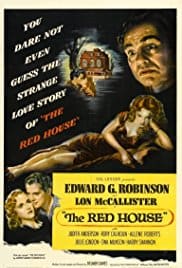 Shared by a man and his sister, what was their secret of the red house in the woods that aroused the curiosity of two young lovers?
Shared by a man and his sister, what was their secret of the red house in the woods that aroused the curiosity of two young lovers?
Edward G. Robinson is best remembered as a gangster. And he made quite a few of those black and white cops and robbers films of the ’30s and ’40s, Tommy guns blazing, most notably Little Caesar (1931) . . . “Is this the end of Rico?,” remember? . . . The Last Gangster (1937), Brother Orchid (1940) and Key Largo (1948), with the similar name of Rocco. In Robin and the 7 Hoods (1964), in a major, but uncredited role, his character, “Big Jim,” crime boss of all Chicago, is gunned down in a volley of fire from his “friends” at his birthday party.
Robinson didn’t make, however, as many gangster films as one might think. True, he is a brutal and sinister sea captain, “Wolf” Larsen, in The Sea Wolf (1941), truly malicious without being a gangster. But he is often on the good side of the law—in Double Indemnity (1944) an insurance executive, in Mr. Winkle Goes to War (1944) a hen-pecked husband who turns into a war hero, in the pre-World War II Confessions of a Nazi Spy (1939) a hunter of Nazis in the German-American Bund and, similarly, in the post-WWII The Stranger (1946) a War Crimes Commissioner after Nazi criminal Franz Kindler (Orson Welles).
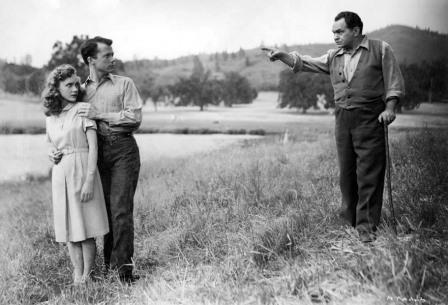 So, as it fell to him in The Red House, he might have escaped his gangster typecasting, but as with his “Wolf” Larsen, he retains his bad guy image in another form, his Tommy gun replaced by a hunting rifle.
So, as it fell to him in The Red House, he might have escaped his gangster typecasting, but as with his “Wolf” Larsen, he retains his bad guy image in another form, his Tommy gun replaced by a hunting rifle.
Suspicions about the integrity of this man, however, are aroused rather early—is he naughty or isn’t he?—building into a delicious affirmation that, yes, he is. Not a surprise, really. Robinson makes this journey, which in many respects is the heart of The Red House, with a restrained, nuanced performance. In the end, his bad guy image is maintained, and he would return the following year to full-fledged gangsterdom in Key Largo.
Teenager Meg (Allene Roberts) arrives home from high school with her twelfth-grade friend, Nath Storm (Lon McCallister). She has been adopted by Pete Morgan (Robinson), who has a stiff right leg. The two, along with his sister, Ellen (Judith Anderson), share an isolated farm near some dark woods, Ox Head.
While Meg has never felt completely at ease around Pete, she convinces him to hire Nath to help out on the farm. Pete warns him to stay out of the woods, that it’s dangerous—nothing further said, no reasons why.
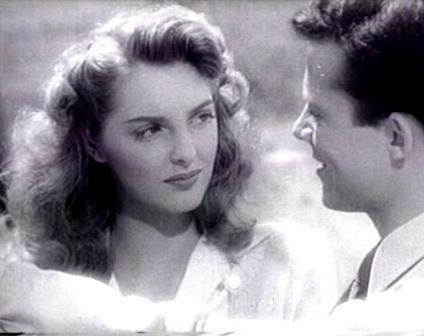 But Nath’s curiosity is aroused and he ventures into the woods, only to be knocked out by someone—and it wasn’t by Pete. He was home with Ellen. Undeterred, Nath, now with Meg and his girlfriend, Tibby (Julie London), explores the woods again. Nothing is found. When Pete finds out, he threatens to whip Meg if she goes into the woods again.
But Nath’s curiosity is aroused and he ventures into the woods, only to be knocked out by someone—and it wasn’t by Pete. He was home with Ellen. Undeterred, Nath, now with Meg and his girlfriend, Tibby (Julie London), explores the woods again. Nothing is found. When Pete finds out, he threatens to whip Meg if she goes into the woods again.
This latest venture has served only to arouse Meg’s growing attraction to Nath and her jealousy of Tibby. Tibby, however, soon leaves Nath for Teller (Rory Calhoun), a vagrant Pete has hired to keep people out of the woods, and the author of Nath’s blow on the head.
One day, Meg finally finds the red house, overgrown in vegetation and beside an unused dirt road. Teller frightens her away with gunshots and, in fleeing, she breaks a leg. After she is treated by Dr. Byrne (Harry Shannon), Pete—a menacing silhouette—enters her room and calls her “Jeanie.”
Pete’s depression and bouts with insanity are caused by haunting memories of the red house. In an argument with Pete, Ellen reminds him, as if he needed reminding, that he had killed Jeanie’s husband in that house fifteen years ago.
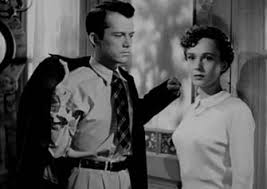 Wishing to wipe out the past, Ellen enters the woods to burn down the red house and the nearby icehouse. In trying to scare her off, Teller accidentally shoots her. Pete refuses to help, saying she had defiled the red house. Meg telephones Nath for help, but Ellen dies before he arrives. After calling the sheriff (Arthur Space), Nath takes Pete’s rife and goes after Teller.
Wishing to wipe out the past, Ellen enters the woods to burn down the red house and the nearby icehouse. In trying to scare her off, Teller accidentally shoots her. Pete refuses to help, saying she had defiled the red house. Meg telephones Nath for help, but Ellen dies before he arrives. After calling the sheriff (Arthur Space), Nath takes Pete’s rife and goes after Teller.
In a lengthy scene, Pete confesses to Meg that, years ago, malicious rumors had been spread in town about his relationship with Jeanie. It was an accident at the red house, he said, that he had suffocated her with his hand over her mouth, trying to stifle her screams, but admitted he did kill her husband when he entered. He placed their bodies in an old surrey and sank it in a mud hole at the icehouse.
Pete further confesses that Meg is Jeanie’s daughter, the reason he had adopted her and has been so possessive of her.
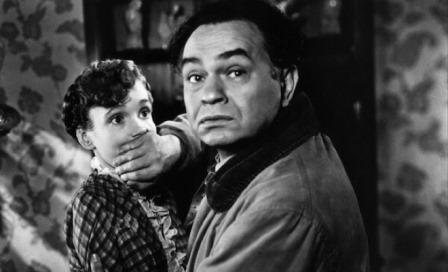 The plot now moving toward a climax, Pete takes Meg in his truck to the red house, and, once inside, now fully deranged, relives that night fifteen years ago, again calling her “Jeanie.” The sheriff, who has captured Teller, arrives with Nath in time to rescue Meg. Pete flees in the truck, but it sinks in the icehouse tarn and he drowns, a carriage wheel floating to the surface.
The plot now moving toward a climax, Pete takes Meg in his truck to the red house, and, once inside, now fully deranged, relives that night fifteen years ago, again calling her “Jeanie.” The sheriff, who has captured Teller, arrives with Nath in time to rescue Meg. Pete flees in the truck, but it sinks in the icehouse tarn and he drowns, a carriage wheel floating to the surface.
Before a serene, broad landscape—without any woods!—Meg and Nath stand together. He has burned to the ground the red house and they are ready for a new life together.
Except for Julie London, who is nothing more than an attractive bauble, and Rory Calhoun, who is a little wooden, Robinson is given excellent support. Judith Anderson is much more subdued than in her most famous screen role as the omnipresent Mrs. Danvers in Alfred Hitchcock’s Rebecca (1941). She serves as Pete Morgan’s moral conscience, yet insists that their secret be kept.
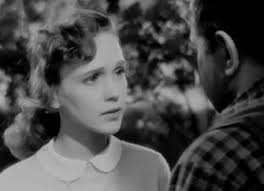 Allene Roberts as Meg, nineteen at the time, is convincing as a high school student and admirably carries her weight in the film, especially in her many ambivalent scenes with Robinson. While Lon McCallister as Nath was twenty-four at the time, his 5’ 6” height and youthful appearance make him equally believable in his role and with acting as expert as Roberts’.
Allene Roberts as Meg, nineteen at the time, is convincing as a high school student and admirably carries her weight in the film, especially in her many ambivalent scenes with Robinson. While Lon McCallister as Nath was twenty-four at the time, his 5’ 6” height and youthful appearance make him equally believable in his role and with acting as expert as Roberts’.
As a small footnote, Ona Munson, Belle Watling in Gone with the Wind (1939), has a small part as Nath’s mother.
With good reason, Miklós Rózsa felt he was “plagued” by the theremin, an electronic instrument that emits a wavering, or oscillating, sound, controlled by the movement of the performer’s hands. Rózsa was the first composer to use it in a film score—initially to express Gregory Peck’s paranoia in Spellbound (1945) and to convey Ray Milland’s alcoholism in The Lost Weekend (1945). To the point of a cliché, it is still used to convey spookiness, insanity or anything disturbing.
When asked to use the theremin yet again in The Red House to express, not Morgan’s insanity as might be expected, but the “haunting” episodes for the red house, Rózsa resisted but complied. Afterward, he never used the instrument again.
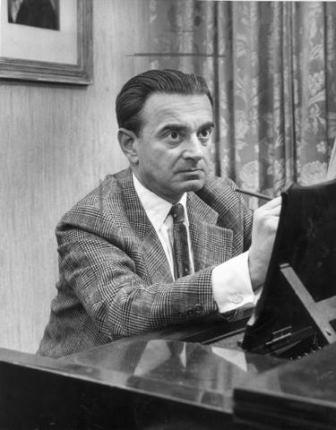
Rózsa had one last confrontation with the theremin when it was proposed for the scene in Ben-Hur (1959) when an unseen Christ gives Judah Ben-Hur (Charlton Heston) a drink of water. The composer was able to substitute an organ instead.
For anyone familiar with the composer’s music, the Red House score is full of his trademarks and agile ability to intensify and contrast varying moods. The ominous main title music with its disturbed orchestration, for example, is followed in the next three or four scenes by calm, rustic sounds as students leave school and swim in the local pond.
When Nath first goes into the woods and the wind howls and he becomes disorientated, the music is front and center, a tour de force for Rózsa’s invention, though this may be the least interesting part of the score. In the climax, when the hallucinatory Morgan threatens Meg at the red house, the music reaches its greatest intensity, even utilizing a wordless chorus.
The score is only one reason—but a most important one—why The Red House is a satisfying experience, all around.
[embedyt] https://www.youtube.com/watch?v=L6HZnUTPyho[/embedyt]